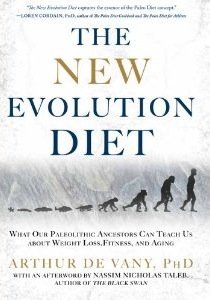Excerpt from ‘The New Evolution Diet’ by Arthur De Vany

 Chapter 7: The Metaphysics Behind the Diet
Chapter 7: The Metaphysics Behind the Diet
First came my boyhood passion for sports and strength. Next was my immersion in the world of nutritional science and metabolism because of my wife’s and son’s diabetes. The third and final element that connects all the dots and accounts for my fascination with the subject of this book: The ways in which the New Evolution Diet has intersected with my intellectual life.
A little background: A great deal of my work as an economist has been in the study of complex systems, such as how natural gas prices are determined by the marketplace. Not surprisingly, given that I had grown up in Southern California and taught at a university there, I eventually turned my attention to a notoriously murky, seemingly impossible-to-forecast industry: Hollywood.
Since its inception, the people running the motion picture business have tried to unlock the mystery of which decisions lead to financial success and which to failure. At some point, all the wisdom had been boiled down to this rueful admission by screenwriter William Goldman: “Nobody knows anything.” That’s exactly the kind of axiom that an economist cannot let stand untested. So in 1995 David Walls and I gathered box office revenue data on 300 Hollywood films and began to investigate what separated the winners from the losers.
This research produced a book, Hollywood Economics, and several scholarly papers, but the gist is this: Goldman was right. There is no way at the outset to plan a movie’s success. Neither the choice of stars or directors or writers nor the genre of movie nor the subject matter were found to make a reliable difference in how the films performed.
Meanwhile, my ad hoc study of health, nutrition, and fitness continued to deepen. I had already begun to discover that our ancestors’ lifestyle from 40,000 years ago could teach us how to live today. Now I was also beginning to perceive the full complexity of the systems and dynamics that determine whether or not we will be healthy.
At some point I realized that a human being is just another economic system. Indeed, your body contains an entire economy. There is the allocation of assets according to a hierarchy of needs. There are competing interests that sometimes struggle over resources and other times cooperate for the common good. There are surpluses. There are shortages. Like economies–like the movie industry–your body is a complex, decentralized system poised between chaos and order.
In the movie business, word-of-mouth reviews, more than anything, were what prompted fans to see one film instead of another. It is a powerful feedback loop made up of millions of small parts, each acting independently. This system has grown exponentially since the advent of the Internet. Where once millions of moviegoers chattered, now there are billions, perpetually in contact with one another, weighing in, arguing, linking, connecting and disconnecting, uploading and downloading.
It mimics perfectly what goes on inside our bodies. Billions of cells, all connected but working autonomously, with no central authority to guide them, take in information. react, then talk back and forth at the speed of electrons, each one responding in small ways that collectively add up to a powerful force.
“Information cascade” is an economics term to describe how even a small piece of knowledge can be amplified as it spreads from one decision maker to another. Your body is also controlled by cascades of information–your bloodstream is hit with a dose of carbohydrate, which is the signal for your pancreas to release insulin, which turns off fat burning and silences the signal from leptin, the hormone that would ordinarily tell your body that it has adequate reserves of energy and need not store any more.
Likewise, in the aging cascade, we lose metabolic fitness. And as a result, insulin rises and we grow more acidic, which further decreases metabolic health, and each event amplifies the momentum of what preceded it.
Hollywood wanted to believe that there was some stable, easy-to-predict dynamic that ruled the movie business. If there were, decisions could be made and investments taken with confidence in their outcome. Similarly, health experts use oversimplified analogies to predict how metabolism manages nutrition and weight. All you have to do is burn more fuel than you take in, we were instructed, and you will reliably lose weight. Burn precisely as much as you consume and you will maintain. Burn less and you’ll gain. Simple arithmetic that doesn’t add up.
We tend to simplify what otherwise seems overwhelmingly complicated. But as we now know, our metabolic function is infinitely complex. I found myself using concepts from other scientific disciplines to help me understand and explain the human body’s inner workings.
According to chaos theory, certain systems that seem to be random in fact are not–it’s just difficult for us to perceive, at the outset, all the subtle factors that set the course and determine the outcome. One landmark of chaos theory is the “butterfly effect.” This says that even a very small, unseen occurrence in a far-off place can have a large eventual impact–that if a butterfly flaps its wings in Hong Kong, the resulting breeze can trigger a cascade of atmospheric events and cause a hurricane in Brazil.
This can be used to explain many of our bodies’ inner workings. Here’s a simple one: If you go to the gym several hours after your last meal (so that you’re on a relatively empty stomach), your body will quickly burn through whatever glycogen is in your muscles and then move on to burning fat, which is the desirable state. But if on your way to the gym you have a sports drink, one with lots of carbs, you’ll need to burn off the glucose first. And depending on your workout, you might never get around to burning fat at all. Same exact exercise routine, very different outcomes, all because of your choice of pre-exercise beverage.
Another scientific concept, the power law, also comes up often in my discussions of health and fitness. It is based on the Pareto principle, named for Italian economist Vilfredo Pareto. In essence, it describes the relationship between how common a factor is and how much influence it exerts. It says that the most unusual events will have the greatest impact. Pareto’s study determined that 80 percent of privately held land in Italy was owned by 20 percent of the population.
Similar power laws exist all around us. This relationship between low frequency and high impact is found again and again, in various fields of science, business, and elsewhere.
There is a power law of exercise, too: Your least frequent, most extreme exertions will have the greatest influence on your fitness. The peak moments of a workout count far more than the amount of time you spend working out. This is why a series of 40-yard sprints at full speed benefits you more than half an hour of jogging. It’s also the reason why lifting a weight heavy enough to make your heart pound and your muscles burn counts more than spending hours at the gym. When a work-out becomes an unvarying, monotonous routine, it loses its effectiveness.
My average output of energy per week may look fairly modest. But the stretches of relaxation are offset by two or three sessions of extremely intense activity, which do most to determine my well-being. Ancient hunter-gatherers spent much of their time doing little or nothing. And then, every so often, they took action that would exhaust any 21st-century gym rat. Overall, they burned twice as much energy as we do.
A few of the personal trainers at my gym laugh at “cardio queens,” people who waste hours on the treadmill and Stair-Master, trudging away but never really pushing themselves to intensity. But many more trainers recommend the unproductive exercise of “doing cardio” because they still subscribe to the energy-in, energy-out model of body weight. By doing the same cardio workout day after day, their bodies adapt to that exact level of energy demand but nothing greater. The internal message these people send is that they don’t need much fast-twitch muscle fiber, and so it atrophies, and as a result, they lose bone mass, too.
I use other terms and concepts that are not normally found in fitness books. Stochasticity, for instance, means “randomness” or “chance.” A living human leaves a “trail” of events and accomplishments that is so complex that it appears to be random. That means there is no model that can compress the information that is required to describe a lifetime. The appearance of randomness is an acknowledgment of the limits of our knowledge. So it is in markets and in life.
My particular form of engagement with the subject of health and fitness has even proven to have a metaphysical side. Each of us has what I call an ensemble of stochastic life paths–the choices we make. You make each choice in life based on your understanding of the possibility that it will take you where you want to be. But you don’t determine the outcome, only the probabilities. Each path leads to more choices: a cascade to echo all the other cascades that rule our lives. Choosing the path is the extent of your control–beyond that, it’s out of your hands. You choose, and then life rolls the dice.
For example, you can determine what you eat and drink and how you will exercise. But then your genes express themselves as they will. They are beyond your control. You can’t even completely determine your genes’ environment, since outside factors (such as air and water quality) and internal ones (like emotional stress) also have a say. I learned about the limits of control when caring for my first wife, Bonnie, through her terminal illness. I learned it again in my studies of the movie industry, and now in the course of my ongoing education in health.
It has even allowed me to recognize, in this thought, the Zen of the hunter-gatherer lifestyle: There is no failure, only feedback.
– Arthur De Vany



